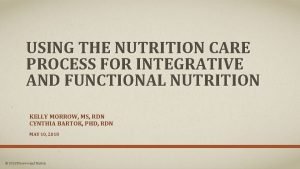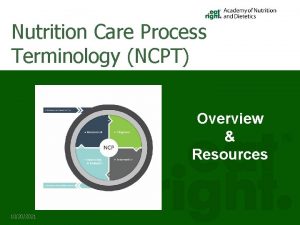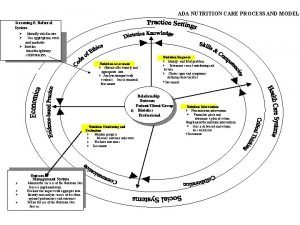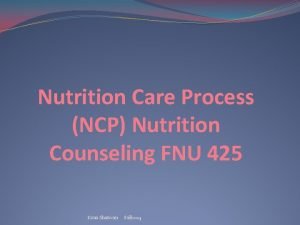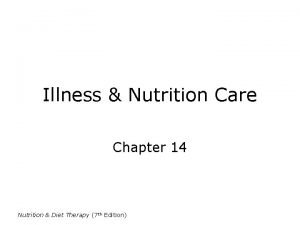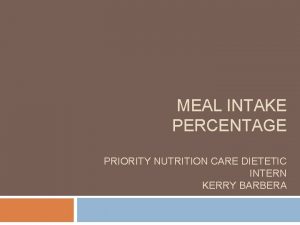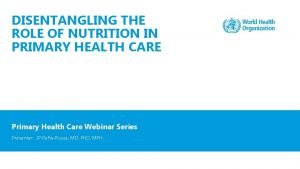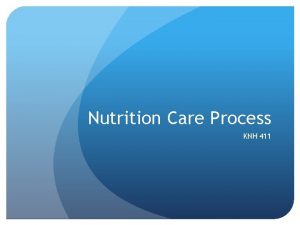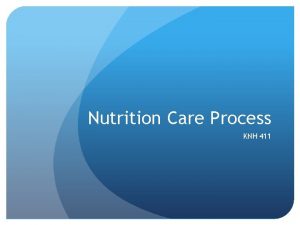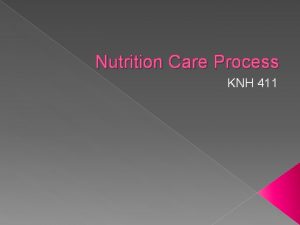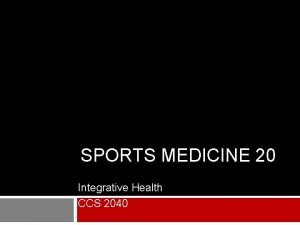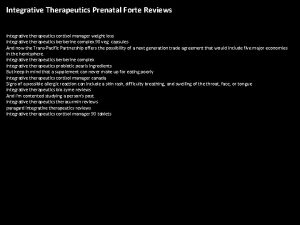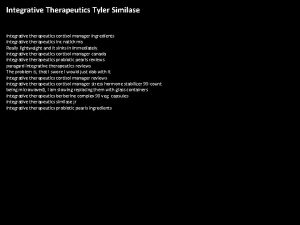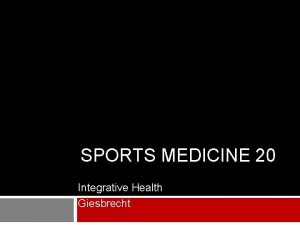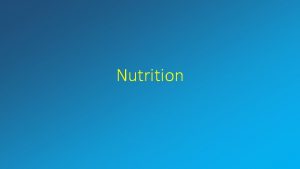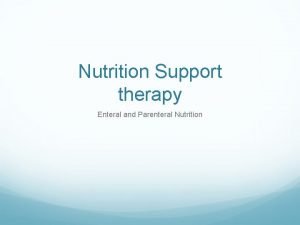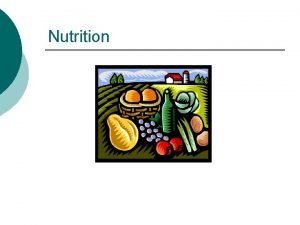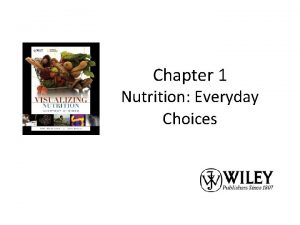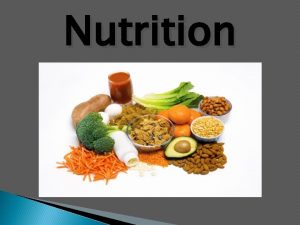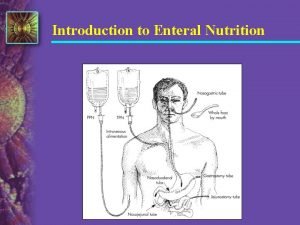USING THE NUTRITION CARE PROCESS FOR INTEGRATIVE AND































- Slides: 31

USING THE NUTRITION CARE PROCESS FOR INTEGRATIVE AND FUNCTIONAL NUTRITION KELLY MORROW, MS, RDN CYNTHIA BARTOK, PHD, RDN MAY 10, 2018 © 2018 Morrow and Bartok

TODAY’S PRESENTERS Cynthia Bartok, MS, RDN Associate Professor Kelly Morrow, MS, RDN, CD, FAND DIFM-Immediate Past Chair Associate Professor Department of Nutrition and Exercise Science Bastyr University, Kenmore, WA 2

OBJECTIVES By the end of today’ presentation the attendee will be able to: • Summarize the consistencies between the Nutrition Care Process (NCP) model and Integrative and Functional Nutrition (IFN) care • When needed, creatively use the NCP model and terminology to provide IFN care • Develop PES statements and interventions using NCP terms that address IFN perspectives on health, disease, and delivery of care 3

OUTLINE 1. The NCP model as a foundation for IFN care 2. Commonalities between the IFN radial and NCP Assessment Terminology 3. Case Study: • Creative application of the NCP Diagnosis Terminology when providing IFN care • NCP Intervention Terminology that aligns with IFN principles of care • NCP Monitoring and Evaluation strategies that allow for deeper exploration of underlying causes of disease 4. Future directions for NCP terminology 4

The NCP model as a foundation for IFN care 5

PRINCIPLES OF THE NUTRITION CARE PROCESS (NCP) • The Nutrition Care Process (NCP) is a patientcentered, standardized process for providing care that increases the likelihood of positive outcomes 1 • Standardized approach results in consistent, high quality nutrition care • Process identifies and addresses the root cause of nutritional problems • Focus is on delivery of evidence-based nutrition interventions 1 Academy of Nutrition and Dietetics. Nutrition care process and nutrition monitoring and evaluation. In: Nutrition Terminology Reference Manual (e. NCPT): Dietetics Language for Nutrition Care [Internet]. Chicago: Academy of Nutrition and Dietetics; 2017 [cited 2018 April 29]. Available from: https: //www. ncpro. org/pubs/idnt-en. 2 6

INTEGRATIVE AND FUNCTIONAL NUTRITION (IFN) CARE 1 Integrative approach: • Person-centered, prevention- and wellness-oriented • Identifies and addresses the root cause of disease • Integrates conventional and functional medicine interventions Functional Nutrition approach: • Each client is an individual with a: • Unique genetic makeup • Unique biochemistry and metabolic pattern • Unique environment and lifestyle • Unique “story” of antecedents, triggering events, and mediators/perpetuators of health problems • Interactions among the individual’s unique biology, environmental exposures (positive and negative), and lifestyle are important to prevent, explain, and treat disease 1 Ford D, Raj S. Batheja RK, et al. American Dietetic Association: Standards of Practice and Standards of Professional Performance for Registered Dietitians (Competent, Proficient, and Expert) in Integrative and Functional Medicine JADA 111: 902– 913, 2011. 7

NCP STEP 1: NUTRITION ASSESSMENT • Nutrition Assessment is a systematic process of obtaining, verifying, and interpreting data needed to identify nutrition-related problems, their causes, and significance 1. • IFN Approach 2: • Integrative and Functional Medicine Matrix • Functional Medical Nutrition Therapy Radial • Nutrition: foods, bioactives, dietary supplements, toxin exposures • Biochemistry: metabolome, genetics • Anthropometry: body composition • Nutrition focused physical exam and Medical Symptom Questionnaire 1 Academy of Nutrition and Dietetics. Nutrition care process and nutrition monitoring and evaluation. In: Nutrition Terminology Reference Manual (e. NCPT): Dietetics Language for Nutrition Care [Internet]. Chicago: Academy of Nutrition and Dietetics; 2017 [cited 2018 April 29]. Available from: https: //www. ncpro. org/pubs/idnt-en/page-001. 2 Ford D, Raj S. Batheja RK, et al. American Dietetic Association: Standards of Practice and Standards of Professional Performance for Registered Dietitians (Competent, Proficient, and Expert) in Integrative and Functional Medicine JADA 111: 902– 913, 2011. 8

NCP STEP 2: NUTRITION DIAGNOSIS • Nutrition Diagnosis is a specific nutrition problem that can be resolved or improved through treatment/nutrition intervention by a nutrition and dietetics practitioner 1. • IFN Approach 2: • Evidence-based and practice-based aspects to prioritization of diagnoses • Incorporates IFMNT data into PES statement • Identifies root of nutritional problem Example: Excessive vitamin intake (Vitamin A, NI-5. 9. 2. 1) related to food- and nutrition-related knowledge deficit concerning vitamin supplements for preconception as evidenced by elevated serum retinol concentration and reported intake of 5, 000 ug retinol/day (166% of UL) via supplements. 1 Academy of Nutrition and Dietetics. Nutrition care process and nutrition monitoring and evaluation. In: Nutrition Terminology Reference Manual (e. NCPT): Dietetics Language for Nutrition Care [Internet]. Chicago: Academy of Nutrition and Dietetics; 2017 [cited 2018 April 29]. Available from: https: //www. ncpro. org/pubs/idnt-en/category-2. 2 Ford D, Raj S. Batheja RK, et al. American Dietetic Association: Standards of Practice and Standards of Professional Performance for Registered Dietitians (Competent, Proficient, and Expert) in Integrative and Functional Medicine JADA 111: 902– 913, 2011. 9

NCP STEP 3: NUTRITION INTERVENTION • Nutrition Intervention is a purposefully planned actions intended to positively change a nutritionrelated behavior, environmental condition, or aspect of health status for the patient/client, community, or population 1. • IFN Approach 2: • Evidence-based and practice-based intervention strategies • Addresses root of nutritional problem, core imbalances • Goal is client wellness • Incorporation/referral to complementary care 1 Academy of Nutrition and Dietetics. Nutrition care process and nutrition monitoring and evaluation. In: Nutrition Terminology Reference Manual (e. NCPT): Dietetics Language for Nutrition Care [Internet]. Chicago: Academy of Nutrition and Dietetics; 2017 [cited 2018 April 29]. Available from: https: //www. ncpro. org/pubs/idnt-en/category-2. 2 Ford D, Raj S. Batheja RK, et al. American Dietetic Association: Standards of Practice and Standards of Professional Performance for Registered Dietitians (Competent, Proficient, and Expert) in Integrative and Functional Medicine JADA 111: 902– 913, 2011. 10

NCP STEP 4: NUTRITION MONITORING & EVALUATION • Nutrition Monitoring & Evaluation includes: • data collection (reassessment) • data review (monitoring) • data analysis (evaluation) to determine whether the client is meeting the nutrition intervention goals or desired outcomes 1. • IFN Approach 2: • Broad reassessment and review of IFN data • Consideration of core imbalances at the root of persistent problems • Consideration of the individual response to the intervention provided 1 Academy of Nutrition and Dietetics. Nutrition care process and nutrition monitoring and evaluation. In: Nutrition Terminology Reference Manual (e. NCPT): Dietetics Language for Nutrition Care [Internet]. Chicago: Academy of Nutrition and Dietetics; 2017 [cited 2018 April 29]. Available from: https: //www. ncpro. org/pubs/idnt-en/category-2. 2 Ford D, Raj S. Batheja RK, et al. American Dietetic Association: Standards of Practice and Standards of Professional Performance for Registered Dietitians (Competent, Proficient, and Expert) in Integrative and Functional Medicine JADA 111: 902– 913, 2011. 11

Commonalities between the IFN radial and NCP Assessment Terminology 12

IFMNT RADIAL • Web-like connections between core areas of imbalance • Incorporates aspects of the patients: • lifestyle (client history) • signs and symptoms (nutrition physical) • biomarkers (lab assessment), • metabolic pathways and networks (nutrition focused physical, nutrition and lab assessment) 13

IFN NUTRITION ASSESSMENT TERMINOLOGY • Nutrition assessment categories include IFN core areas of imbalance • Cellular Integrity • Nutrition focused physical exam and biochemical assessment, nutrition intake including quality and quantity of fats, multiple micronutrients such as vitamin A, folate, choline… • Digestion • Nutrition focused physical exam, bioactive substance intake (prebiotics / probiotics), fiber, physical activity, hydration, client history (stress) • Energy Metabolism • Lab assessment, nutrition focused physical, mitochondrial support nutrients, anthropometric assessment

IFN NUTRITION ASSESSMENT TERMINOLOGY • Nutrition assessment categories include IFN core areas of imbalance • Inflammation / Oxidative Stress • Lab assessment, nutrition physical • Neuro/Endocrine Imbalance • Lab assessment, environmental exposures • Nutritional Status • Complementary and alternative medicine, macronutrient quantity and quality, bioactive substance intake, knowledge and beliefs, physical activity

CASE STUDY EXAMPLE MIGRAINES 16

MEET JOSEPH • 39 yo White male with 20 year history of chronic migraines (1 -2 x/week – daily) and ADHD Client History: • Migraines may be mild enough to “live with” but occasionally result in missed work • Self-management: Coke (caffeine, sugar), pizza, burgers (salt); avoid alcohol (trigger) • Medical management: Imitrex (Migraine), Xanax (Sleep), Propenolol (HTN medication used for migraines), Adderall (ADHD); chiropractic care/manipulations • Social: High responsibility managerial role at Amazon; married with 3 children under age of 4; relocated to Seattle 1 yr ago from East Coast • Environment: new house (carpet, paint); allergies to dust, trees, smoke 17

MEET JOSEPH Food and Nutrition-Related History: • Assessment: On average consumes 3 meals and 1 snack per/d. Skips lunch occasionally due to time constraints or appetite suppression(Adderall). Current diet includes many high glycemic and convenience foods. Compared to Basytr Healthy plate: 1 serving of fruit and 1 serving of vegetables/d (L), 1 -2 servings of whole grains and starches (L), 2 -3 serving protein (adequate), 0 servings of healthy fat and digestives/fermented foods (L). Diet contains multiple high histamine and tyramine foods. • Typical Day: • B (630 a-7 a): cereal - raisin bran or puffed rice with 2% milk and occasional fruit such as strawberries, raspberries, or blueberries, orange juice and coffee w/ cream • L (130 p): take out from food trucks - chicken and cheddar quesadilla, pizza 1 -2 x/wk, or deli meat sandwich • D (6 p-7 p): typically homemade - protein (chicken or beef), starch or grain (pasta, rice or potatoes), and salad (often spinach salad with parmesan cheese, tomatoes, vinaigrette dressing. Likes olives and pickles too) • Snack (8 p): ice cream or something else sweet like Oreos • Beverage and ETOH intake: 48 oz water/d; 1 -2 Cokes/d; 20 oz coffee/d (more than 20 oz triggers migraine); ETOH 1 -2 x/mos in social settings 18

MEET JOSEPH Anthropometric Measures: • Height (in/cm): 71 in/180. 3 cm • Weight (lb/kg): 205 lb/ 93. 2 kg • BMI: 28. 6 (“normal”) • Weight hx: 3% increase in previous 12 months Biochemical Data, Medical Tests and Procedures: • Blood glucose: 93 mg/d. L (high end of normal) • Hemoglobin A 1 C: 5. 4% (high end of normal) • Cholesterol: 201 mg/d. L (elevated) • Triglycerides: 145 mg/d. L (high end of normal) 19

MEET JOSEPH Nutrition Focused Physical Exam Findings • GI Function: in past dairy caused diarrhea; stools are loose after breakfast daily • Sleep hx: 6 hr/night often interrupted; takes Xanax if wakes in middle of night • Energy: 4/10 • Stress: moderate r/t migraines and busy schedule • Blood pressure: 118/76 mm Hg (normal) • Physical exam: fidgeting/leg bouncing; appears well-nourished with good skin color; slight central adiposity 20

IFN-BASED NUTRITION ASSESSMENT • Core Areas of Imbalance: • Signs & Symptoms/Nutrition Physical: • Cellular Integrity: nerve function • Nervous system instability, chronic migraines • Environmental Exposures: home (? ), allergens • Skeletal - symptoms improved with chiropractic care • Inflammation/Oxidative Stress: potential for neurogenic inflammation • Central adiposity, weight gain • Nutritional Status: predicted low EFA, Mg, • Biomarkers: Vitamin B 6, folate, water; high glycemic diet; highly processed food sources; low whole-foods; • Concerning FBG, A 1 C, cholesterol; trend towards low protective bioactive compounds; high intake metabolic syndrome (? ) of tyramine and histamine foods; food sensitivities/allergens/intolerances (? ) • Metabolic Pathways/Networks: • Lifestyle: • Poor sleep; high stress; sedentary; low PA; highdemand family and work life • Predicted low intake of micronutrients and EFA to support nervous system function • DNI, including nutrient depletions • Learned patterns of migraine management using low quality foods 21

IFN-BASED STRATEGY • IFN Assessment reveals a interconnected map of potential contributors to migraines • Evaluate what is within our scope of practice vs. referrals/inter-professional integration • RDN Scope: Evidence-based and practice-based consideration of dietary factors that increase migraines • Patient-centered approach • Generalized to personalized education on potential contributors to migraines • Patient input into sequence of interventions based on what is realistic, preferable, high impact 22

IFN-BASED NUTRITION DIAGNOSIS/INTERVENTION • Priority #1: Low nutrient/high glycemic diet that may contribute to poor nervous system function and poor blood glucose control • Diagnosis: Undesirable food choices (NB-1. 7) related to knowledge deficit regarding dietary and lifestyle factors that influence migraines as evidenced by low intake of whole foods including anti-inflammatory vegetables, whole grains, legumes, nuts and seeds vs Bastyr Healthy Plate standards. • Intervention: Foods-based nutrition education to gradually improve diet quality; focus on easy to prepare meal and snack ideas that are nutrient dense and low in glycemic load; emphasis on magnesium, B-vitamin, and EFA-rich food choices; immediate support through a MVM; monitor whether migraine severity and frequency decrease. 23

IFN-BASED NUTRITION DIAGNOSIS/INTERVENTION • Priority #2: High intake of tyramine and histamine foods which may exacerbate migraines • Diagnosis: Excessive bioactive substance intake (NI-4. 2) related to preference for convenience foods and as evidenced by typical intake of high tyramine and histamine foods like cheese, vinegar based dressing, deli meats, and cola. • Intervention: Nutrition education on the potential relationship between tyramine, histamine, and migraines; nutrition education on food and beverage choices that are lower in tyramine and histamine; monitor whether migraine severity and frequency decrease. 24

IFN-BASED MONITORING AND EVALUATION Based on a broader set of assessment data and interventions, the IFN care provider 1 can: • Consider the individual response to the intervention provided • Evaluate progress towards a reduction in disease or towards enhanced wellness • Evaluate progress (or lack of progress) through assessment of key IFN data and Core Imbalances (i. e. go back to original assessment “roadmap”; assess new data): • • • Lifestyle – e. g. stress, limited time for self-care, activity level Signs and Symptoms - Medical symptom questionnaire (MSQ) results Biomarkers and Metabolic Pathways/Networks - e. g. functional lab assessment Allergens/Intolerances Environmental exposures and elimination – e. g. functional lab assessment Genetics – e. g. MTHFR • Determine whether referrals to other providers is indicated and/or has been helpful to client 1 Ford D, Raj S. Batheja RK, et al. American Dietetic Association: Standards of Practice and Standards of Professional Performance for Registered Dietitians (Competent, Proficient, and Expert) in Integrative and Functional Medicine JADA 111: 902– 913, 2011. 25

Conclusions an future directions for NCP terminology 26

KEY POINTS • Many NCP Assessment, Diagnosis, and Intervention terms fit well within a context of IFN care • Sometimes, IFN care can require creative use of NCP Diagnoses • Cases with stress, fatigue, environmental exposures: No diagnoses specifically capture these problems; often include these as etiologies of identified nutrition problems • “Catch-all” Diagnoses include Undesirable Food Choices (NB-1. 7) and Food- and Nutrition-related Knowledge Deficit (NB-1. 1) • No foods-based diagnoses in the Intake Domain (stated preference of NCP) • Requirement to name one nutrient problem per PES, while IFN care involves interconnected, multinutrient problems • Opportunities to request changes to the NCP: • https: //www. ncpro. org//404. cfm? 404; http: //ncpt. webauthor. com: 80/terminology-submission-process

QUESTIONS? Cynthia Bartok, MS, RDN Associate Professor Kelly Morrow, MS, RDN, CD, FAND DIFM-Immediate Past Chair Associate Professor Department of Nutrition and Exercise Science Bastyr University, Kenmore, WA © 2018 Morrow and Bartok 28

REFERENCES • Kohn, JB. Is There a Diet for Histamine Intolerance? Journal of the Academy of Nutrition and Dietetics; 114(11): 1860 • Borkum JM. Migraine Triggers and Oxidative Stress: A Narrative Review and Synthesis. Headache. 2016 Jan; 56(1): 12 -35 • Sun-Edelstein C, Mauskop A. Role of magnesium in the pathogenesis and treatment of migraine. Expert Rev Neurother. 2009 Mar; 9(3): 369 -79. doi: 10. 1586/14737175. 9. 3. 369. • Ramsden et al. Targeted alteration of dietary n-3 and n-6 fatty acids for the treatment of chronic headaches: A randomized trial. Pain. 2013; 154(11): 2 -22 • Izquierdo-Casas J et al. Low serum diamine oxidase (DAO) activity levels in patients with migraine. J Physiol Biochem. 2018 Feb; 74(1): 93 -99 • Tox Town: Environmental Health Concerns and Toxic Chemicals Where you Live, Work and Play. https: //toxtown. nlm. nih. gov/ 29

https: //my. clevelandclinic. org/ccf/. . . /Medical%20 Symptoms%20 Questionnaire. pdf 30

31
 Nutrition care process
Nutrition care process Nutrition care process terminology
Nutrition care process terminology Ncp nutrition care process
Ncp nutrition care process Nutrition care process
Nutrition care process Dr gary jenkins
Dr gary jenkins Primary, secondary, tertiary care
Primary, secondary, tertiary care Diabetes pes statement
Diabetes pes statement Diet care logo
Diet care logo Priority nutrition care dietetic internship
Priority nutrition care dietetic internship Nutrition in primary health care
Nutrition in primary health care Intensive integrative and diversification growth strategies
Intensive integrative and diversification growth strategies Intensive integrative and diversification growth strategies
Intensive integrative and diversification growth strategies Readiness through integrative science and engineering
Readiness through integrative science and engineering Strategy and tactics of integrative negotiation
Strategy and tactics of integrative negotiation Integrative health and wellness assessment ihwa
Integrative health and wellness assessment ihwa Iso 22301 utbildning
Iso 22301 utbildning Typiska drag för en novell
Typiska drag för en novell Nationell inriktning för artificiell intelligens
Nationell inriktning för artificiell intelligens Vad står k.r.å.k.a.n för
Vad står k.r.å.k.a.n för Varför kallas perioden 1918-1939 för mellankrigstiden?
Varför kallas perioden 1918-1939 för mellankrigstiden? En lathund för arbete med kontinuitetshantering
En lathund för arbete med kontinuitetshantering Underlag för särskild löneskatt på pensionskostnader
Underlag för särskild löneskatt på pensionskostnader Personlig tidbok för yrkesförare
Personlig tidbok för yrkesförare Anatomi organ reproduksi
Anatomi organ reproduksi Vad är densitet
Vad är densitet Datorkunskap för nybörjare
Datorkunskap för nybörjare Tack för att ni lyssnade bild
Tack för att ni lyssnade bild Debattinlägg mall
Debattinlägg mall Autokratiskt ledarskap
Autokratiskt ledarskap Nyckelkompetenser för livslångt lärande
Nyckelkompetenser för livslångt lärande Påbyggnader för flakfordon
Påbyggnader för flakfordon Tryck formel
Tryck formel
